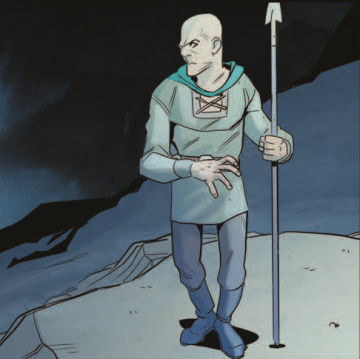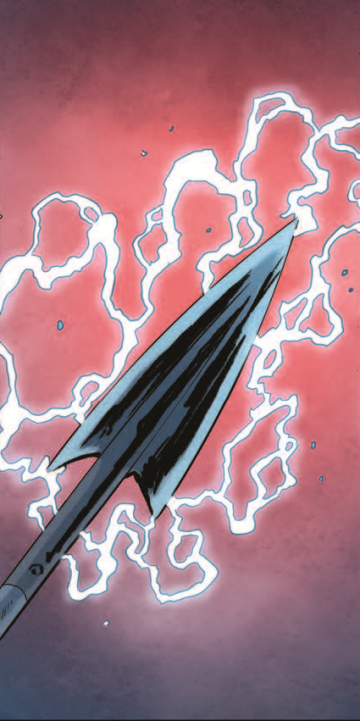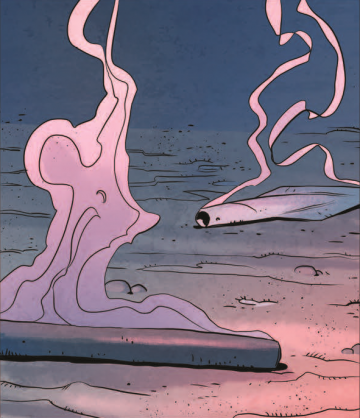Difference between revisions of "Gugnir"
(→Real World Background) |
Phoenician (talk | contribs) |
||
| Line 6: | Line 6: | ||
==History== | ==History== | ||
| − | Gugnir was used by [[Valois|Lord Valois]] to aid [[Culen|King Culen]] against [[Kenneth II]] in [[Timeline#Before 994|971]]. Valois used the Hasta Fatum to conjure up watery hands to attack the [[Wyvern Clan|Wyvern]] [[gargoyle]]s, when they came to Kenneth II's aid in the battle with Culen. The [[Archmage]] counter-attacked with a [[Lightning Spell|spell]], severing the spearhead from the shaft. ''([[The Draw|"The Draw"]])'' | + | Gugnir was used by [[Valois|Lord Valois]] to aid [[Culen|King Culen]] against [[Kenneth II]] in [[Timeline#Before 994|971]]. Valois used (what he referred to as) the Hasta Fatum to conjure up watery hands to attack the [[Wyvern Clan|Wyvern]] [[gargoyle]]s, when they came to Kenneth II's aid in the battle with Culen. The [[Archmage]] counter-attacked with a [[Lightning Spell|spell]], severing the spearhead from the shaft. ''([[The Draw|"The Draw"]])'' |
| − | At an unknown point in time, the lancehead became the prize of [[Anapaula Aguilar|Anapaula Aguilar's]] husband's collection | + | At an unknown point in time, the lancehead became the prize of [[Anapaula Aguilar|Anapaula Aguilar's]] husband's collection, despite unsuccessful attempts in acquiring the haft. By [[Timeline#1997|1997]], Doña Aguilar kept in her home in [[Buenos Aires]], [[Argentina]]. When [[Demona|Dominique Destine]] paid the [[human]] (and her collection) a visit, she timed it to sunset so that she could transform into a gargoyle and steal the lancehead. The lancehead is now in [[Demona's Townhouse]] in [[New York City]]. ''([[Questions|"Questions"]])'' |
==Real World Background== | ==Real World Background== | ||
| − | In Norse mythology, Gugnir (actually, Gungnir) was the spear of Odin. It was forged for him by a group of dwarves known as the Sons of Ivaldi (they were hired to do so by Loki; he had cut off the hair of Thor's wife Sif, and to stop an enraged Thor from beating him up, got the dwarves to make fresh hair for Sif | + | In Norse mythology, Gugnir (actually, Gungnir) was the spear of Odin. It was forged for him by a group of dwarves known as the Sons of Ivaldi (they were hired to do so by Loki; he had cut off the hair of Thor's wife Sif, and to stop an enraged Thor from beating him up, got the dwarves to make fresh hair for Sif – and, presumably to mollify the gods' wrath further, not only the spear Gungnir, but also a magic ship named Skidbladnir for the god Freyr). Like the Gugnir of ''[[Gargoyles (TV series)|Gargoyles]]'', Gungnir always hit its mark. |
Richard Wagner included a version of this spear in his ''Ring of the Nibelung'' operatic cycle, though here unnamed. In Wagner's account, Wotan (his version of Odin) made the spear from a branch of the World Tree (Wagner's version of Yggdrasil), killing the tree in the process. He carved various runes on its shaft, to represent the laws he had sworn to uphold as the ruler of the gods. In the third opera in the cycle, ''Siegfried'', the human warrior Siegfried breaks the spear in half battling Wotan, marking the end of Wotan's reign; Wotan takes the remains of the spear back to Valhalla, there to await his end and that of the gods. | Richard Wagner included a version of this spear in his ''Ring of the Nibelung'' operatic cycle, though here unnamed. In Wagner's account, Wotan (his version of Odin) made the spear from a branch of the World Tree (Wagner's version of Yggdrasil), killing the tree in the process. He carved various runes on its shaft, to represent the laws he had sworn to uphold as the ruler of the gods. In the third opera in the cycle, ''Siegfried'', the human warrior Siegfried breaks the spear in half battling Wotan, marking the end of Wotan's reign; Wotan takes the remains of the spear back to Valhalla, there to await his end and that of the gods. | ||
Latest revision as of 18:33, 18 April 2024
Gugnir was a magic spear, also known as the Odinspear and the Lance of Fate. Following the destruction of the Three Keys to Power, it became one of the Three New Keys to Power.
History
Gugnir was used by Lord Valois to aid King Culen against Kenneth II in 971. Valois used (what he referred to as) the Hasta Fatum to conjure up watery hands to attack the Wyvern gargoyles, when they came to Kenneth II's aid in the battle with Culen. The Archmage counter-attacked with a spell, severing the spearhead from the shaft. ("The Draw")
At an unknown point in time, the lancehead became the prize of Anapaula Aguilar's husband's collection, despite unsuccessful attempts in acquiring the haft. By 1997, Doña Aguilar kept in her home in Buenos Aires, Argentina. When Dominique Destine paid the human (and her collection) a visit, she timed it to sunset so that she could transform into a gargoyle and steal the lancehead. The lancehead is now in Demona's Townhouse in New York City. ("Questions")
Real World Background
In Norse mythology, Gugnir (actually, Gungnir) was the spear of Odin. It was forged for him by a group of dwarves known as the Sons of Ivaldi (they were hired to do so by Loki; he had cut off the hair of Thor's wife Sif, and to stop an enraged Thor from beating him up, got the dwarves to make fresh hair for Sif – and, presumably to mollify the gods' wrath further, not only the spear Gungnir, but also a magic ship named Skidbladnir for the god Freyr). Like the Gugnir of Gargoyles, Gungnir always hit its mark.
Richard Wagner included a version of this spear in his Ring of the Nibelung operatic cycle, though here unnamed. In Wagner's account, Wotan (his version of Odin) made the spear from a branch of the World Tree (Wagner's version of Yggdrasil), killing the tree in the process. He carved various runes on its shaft, to represent the laws he had sworn to uphold as the ruler of the gods. In the third opera in the cycle, Siegfried, the human warrior Siegfried breaks the spear in half battling Wotan, marking the end of Wotan's reign; Wotan takes the remains of the spear back to Valhalla, there to await his end and that of the gods.
"Hasta Fatum" is Latin for "Spear of Fate". ("Hasta" is a technical term for a kind of thrusting spear used in ancient Rome.)


